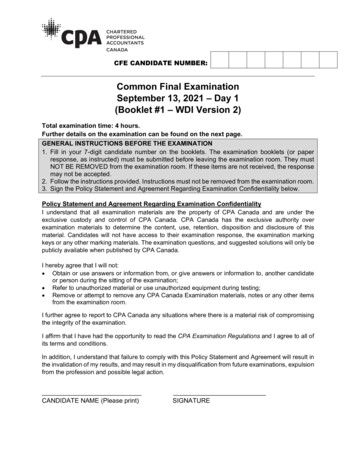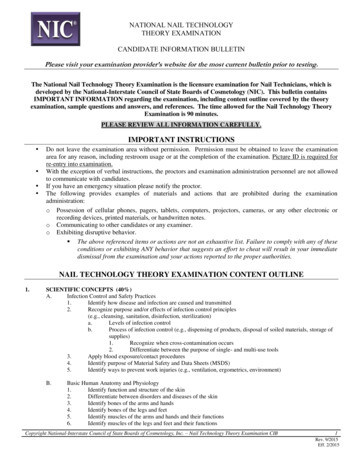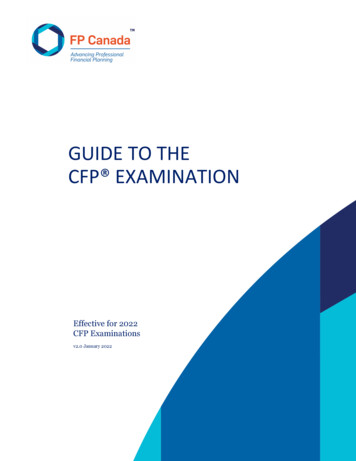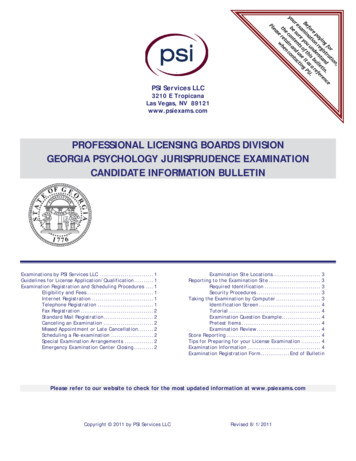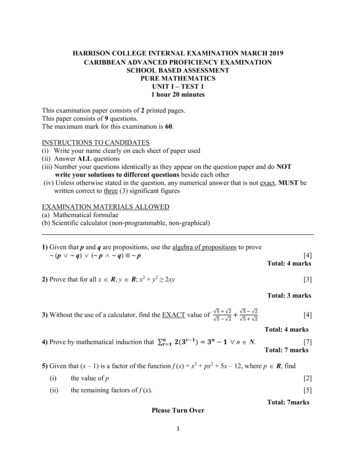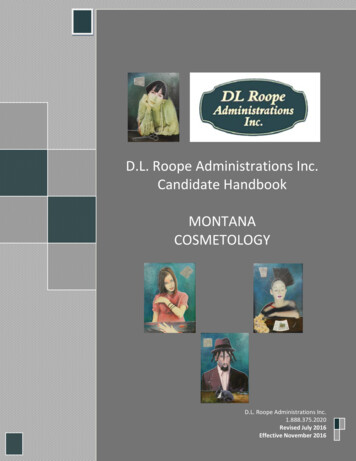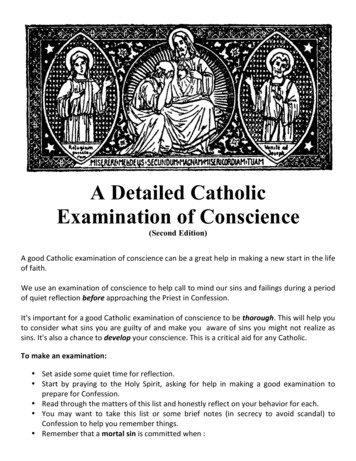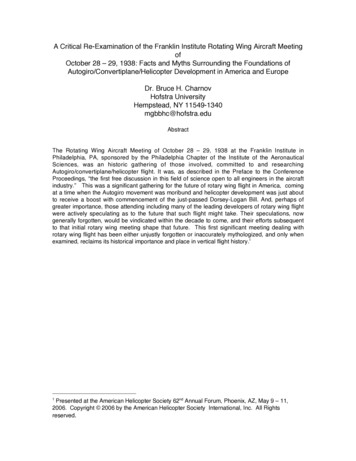
Transcription
A Critical Re-Examination of the Franklin Institute Rotating Wing Aircraft MeetingofOctober 28 – 29, 1938: Facts and Myths Surrounding the Foundations ofAutogiro/Convertiplane/Helicopter Development in America and EuropeDr. Bruce H. CharnovHofstra UniversityHempstead, NY 11549-1340mgbbhc@hofstra.eduAbstractThe Rotating Wing Aircraft Meeting of October 28 – 29, 1938 at the Franklin Institute inPhiladelphia, PA, sponsored by the Philadelphia Chapter of the Institute of the AeronauticalSciences, was an historic gathering of those involved, committed to and researchingAutogiro/convertiplane/helicopter flight. It was, as described in the Preface to the ConferenceProceedings, “the first free discussion in this field of science open to all engineers in the aircraftindustry.” This was a significant gathering for the future of rotary wing flight in America, comingat a time when the Autogiro movement was moribund and helicopter development was just aboutto receive a boost with commencement of the just-passed Dorsey-Logan Bill. And, perhaps ofgreater importance, those attending including many of the leading developers of rotary wing flightwere actively speculating as to the future that such flight might take. Their speculations, nowgenerally forgotten, would be vindicated within the decade to come, and their efforts subsequentto that initial rotary wing meeting shape that future. This first significant meeting dealing withrotary wing flight has been either unjustly forgotten or inaccurately mythologized, and only whenexamined, reclaims its historical importance and place in vertical flight history.11Presented at the American Helicopter Society 62nd Annual Forum, Phoenix, AZ, May 9 – 11,2006. Copyright 2006 by the American Helicopter Society International, Inc. All Rightsreserved.
The 1938 Meeting: Battlefield or Conspiracy?The October 1938 Rotating Wing AircraftMeeting at the Franklin Institute in Philadelphia haslargely been relegated to obscurity in the almostseven decades since those who would primarilyfashion the emergence of the helicopter and advance rotary wing flight for the majority of theremaining years of the 20th century gathered toshare information and exchange ideas. Only twomajor authors – Frank Kingston Smith in Legacy ofWings: The Story of Harold F. Pitcairn1, whichdeals with the American Autogiro pioneer, and JayP. Spenser in Whirlybirds: A History of the U.S.Helicopter Pioneers 2 discuss this meeting, andeach, as discussed infra based on an analysis ofthe actual meeting presentations and comments,derives a seemingly biased view.3 Even those inattendance (and who made presentations), whowere even then or about to play significant roles inhelicopter development, fail to cite the 1938 meeting in their later biographical writings, most notablyH. Franklin Gregory4 and W. Laurence LePage.5Spenser describes that 1938 meeting in thismanner:“Late in 1938 and 1939, he [Igor Sikorsky]and other helicopter pioneers attended twoprofoundly significant symposia at Philadelphia’s venerable Franklin Institute.[6]Organized by the Institute of AeronauticalSciences – predecessor of today’s American Institute of Aeronautics and Astronautics – which cosponsored the eventswith the Franklin Institute, the now-forgotten Rotating Wing Aircraft Meetings offered a priceless forum for pooling knowledgeand exchanging ideas. . . (emphasisadded)These gatherings were convened to advance both the [A]utogiro and the helicopter. Since no helicopter industry existed,the [A]utogiro community – represented byHarold Pitcairn, [W.] Wallace Kellett, [E.]Burke Wilford, Dick Prewitt, [W.] LaurenceLePage, and Agnew Larsen, among others– initially dominated the proceedings. Atthe first meeting, LePage (who in November 1938 formed a helicopter companywith mechanical engineer Haviland Platt)showed movies of Germany’s FockeAchgelis Fa 61 helicopter, inspiration forthe Platt-LePage XR-1 helicopter of 1941. . . Proponents of the sharply divided[A]utogiro and helicopter camps set forththeir views during these forums. Therewas universal agreement that the helicopter was enormously more complex thanthe [A]utogiro, but heated differencesemerged over whether the former wasworth the cost and bother when the lattercould already everything short of hoverand fly vertically.”7But if for Spenser the 1938 meeting was abattlefield upon which the proponents of the Autogiro and helicopter faced off, as will be seen, hemisconstrues the timing – it is after the Autogirohas lost the battle; while Pitcairn admirer FrankKingston Smith, in what can justly be described asa ‘devotional biography’ (privately printed by thePitcairn family), portrayed the occasion in a moresinister and conspiratorial8 manner. He wrote:“[Jim] Ray arrived at the Port of New York[sic] of October 26, 1938, accompanying,by sheer coincidence, an English helicopter inventor named Raoul Hafner [9], whowas on his way to Philadelphia to attendthe meeting on rotary-wing aircraft sponsored by the Philadelphia chapter of theInstitute of Aeronautical Sciences at theFranklin Institute. The convocation, arranged by Ralph H. McClarren, himself aneminent rotary-wing engineer, and E.Burke Wilford, of Gyroplane fame, wasslated to be a major gathering of experts inthe narrowly defined discipline. Professor[Heinrich K. J.] Focke and Louis Bréguethad been invited, but had declined for personal reasons, sending papers to be readat the meeting by their friend Hafner. All ofAmerica’s leaders in the new science appeared, ex-cept Harold Pitcairn, who wasconfined to bed by illness, and heard presentations by such outstanding practitioners of rotary wing as Richard H. Prewitt,Gerard P. Herrick, (sic) Havilland Platt, W.[sic] Lawrence Le-Page, and [E. Burke]Wilford. Speeches were made by Congressman Dorsey and Lieutenant [H.]Franklin Gregory; Jim Ray reported on hisrecent experiences in Europe in an impromptu, completely extemporaneousspeech, and introductions were acknow-
ledged by Grover Loening, W. WallaceKellett, and several army officers in theWright Field program. Pitcairn was wellrepresented by Agnew Larsen and PaulStanley. Another extremely interestedspectator was Michael Gluhareff, an engineer long associated with Igor I. Sikorsky.During luncheon, Gluhareff, seated next toGregory, informed him that Sikorsky hadrecently turned his full attention to thetechnical problems of hovering flight andcontrol systems involved with it and invitedGregory to visit United Aircraft’s VoughtSikorsky laboratory in Stafford, Connecticut.[10] Having already visited the Pitcairnand Kellett organizations while he was inPhiladelphia, Gregory said he would detour to Stafford on his way back to WrightField. It was an invitation that he could notrefuse.”11Smith would have his readers believe thatH. Franklin Gregory was even then entering into aconspiracy with the Sikorsky company to channelDorsey-Logan funds for rotary wing aircraft development and deny the Autogiro developmentalfunds! Dr. Sergei Sikorsy has effectively debunkedthis conspiratorial assertion12 and Gregory’s ownrecollection of the visit to Stratford claimed, with adecidedly non-conspiratorial emphasis, that:“As early as 1938, Major Carl F. Greene(now a full colonel and Matérial CommandLiaison Officer at the National AdvisoryCommittee for Aeronautics (NACA) [13]Laboratories, Langley Field) and I visitedthe Vought-Sikorsky Division in Stratford,Connecticut, to investigate the experiments the Sikorsky people were conducting on a new mechanism for verticalflight. Correspondence about the devicehad been sent to the Matérial Division, andthe Army deemed it worth-while lookinginto it. This was, too, a time when we werelooking for a new-type rotary-wing craft.Igor Sikorsky was not then at the plant butin Europe. His associates, Michael Gluhareff and Boris P. Labensky, showed usthe unusual device, which was not a flyingmachine, but a test rig for trying out various rotor combinations.”14 (emphasisadded)So, if viewing the 1938 meetings through acritical lens from a vantage point almost 70 yearslater fails to substantiate the posited confrontational or conspiratorial frame, what exactly did happenin late October at the Franklin Institute? The answer to that long overdue question will restore thishistoric gathering to its rightful position in the history of rotary wing flight, and provide insight onwhat will come to be justifiably seen as the moment when the Autogiro failed and the helicopter began an ascent that continues to this day.The 1938 Meeting: An Historical GatheringThe Proceedings of the Rotating WingAircraft Meeting (142 pages of printed text 13pages of diagrams) begins with an anonymousacknowledgement15 on the first page of thanks onbehalf of the Philadelphia Chapter of the Instituteof Aeronautical Sciences, defining the scope of themeetings as “Uses, Developments and Relation tothe Future of Heavier-than-Aircraft.” It also pointedout that the Meeting delegates were invited to attend the regular meeting of the Franklin Institute onthe Thursday evening prior to the conference atwhich there would be a lecture in the Hall of Aviation entitled “Principles of Rotary Aircraft” by Dr.Alexander Klemin, Professor, Daniel Guggenheim16 School of Aeronautics, New York University,an auspicious start as he was then arguably themost renowned exponent of rotary-wing theory inthe United States.17The Introduction then proclaimed that “[i]twas rather fitting that registration take place in thislarge hall devoted to a splendid collection of aviation exhibits and particularly in view of the fact,hanging from the ceiling is the first autogiro built inthis country.” While the setting in the Hall of Aviation was undoubtedly inspiring for the aviationminded, the claim that the aircraft hanging abovethe registrants was the “first autogiro built in thiscountry” is clearly incorrect. It was, in fact, theoldest surviving American-built Autogiro, the Pitcairn PCA-1A.18 Pitcairn’s first experimental American-built Autogiro, the PCA-1, had been badly damaged in an accident while being flown by Juan dela Cierva in early October, 1929 and was destroyed in a fire that consumed the older Pitcairn hanger in Bryn Athyn, PA on November 18, 1929.19The oldest Autogiro in America was (andis) the Cierva C.8W,20 and although there is somecontroversy21 as to the date and pilot on the firstflight in the ‘New World’, it now established that the
Cierva aircraft was first flown in America by Ciervatest-pilot Arthur “Dizzy” Rawson on December 18,1928.22 When the evaluation of the C.8W wascomplete, Pitcairn presented it to the National Airand Space Museum of the Smithsonian Institutionon July 17, 1931 and it was accepted by Dr. Charles Greely Abbot, Secretary of the Smithsonian Institution when James G. “Jim” Ray landed on theNational Mall on July 22, 1931.23 The C.8W wason display for several years, but was transferred tothe Smithsonian storage facility at Silver Hill, MDwhen it began to deteriorate. In 1982 Walter J.Boyne, who became Director of the National Airand Space Museum in February 1983, wrote thatAmerica’s first rotary-wing aircraft “was scheduledfor restoration in the near future.”24 That was 21years ago and the C.8W still has not been restoredand placed in an honored position in the Smithsonian. That aircraft awaits restoration at the Paul S.Garber Center of the National Air and Space Museum.25The Introduction then notes that “Mr. E.Burke Wilford, President of the Philadelphia Chapter acknowledges his gratefulness to the committee consisting of Agnew E. Larsen, W. LaurenceLePage, Richard H. Prewitt, James G. Ray andRalph H. McClarren, Secretary.” This is telling inthat Wilford, along with McClarren, was then active in the development of the Wilford Gyroplane;Ray and Larsen represented the Autogiro Company of America and the Pitcairn interests; RichardH. Prewitt was chief engineer of the Kellett Autogiro Company while LePage, a ‘consulting engineer’, was beginning development of one of America’s first helicopters. It was a solid representationof the American rotary-wing community, with theexception of Igor Sikorsky and Harold Pitcairn (whowas ill), appearing heavily but not exclusively tiltedtoward the Autogiro, but appearances were toprove deceiving.Wilford, who had previously done significant work for the Pennsylvania Aircraft Syndicatedirected towards aircraft safety, purchased the patent rights to the work of German inventor and aircraft designers Walter Rieseler and Walter Kreiserin 1925, thus predating Pitcairn’s involvement withCierva. The rights to Rieseler and Kreiser’s rigidblade gyroplane would be assigned to Wilford in U.S. Parent 1,777,678.26 He called his craft the WRKGyroplane (X794W)27 and it first flew on August 5,1931. It differed from the Cierva and Pitcairn models of the time in that utilized a rigid rotor capableof cyclic pitch variation. The pitch of the rotorblades changed as they rotated, a mechanism toequalize lift in place of the Cierva flexible bladesand “flapping hinges”. This use of cyclic pitch alsoafforded a measure of control, but the Wilford model also retained wing and tail control surfaces.28While the Navy would eventually evaluate his second XOZ-1 Gyroplane in 1935 – 36, and it wouldbe tested by the N.A.C.A., Wilford was never aserious contender to either Pitcairn or Kellett inAutogiro development. This was, in part, becausehis test pilot Joseph McCormick, brother of WilliamMcCormick who had been with RADM RichardEvelyn Byrd to the South Pilot as his Autogiro pilot,died in a 1934 crash of a Wilford prototype.29Of greater interest, in terms of the latercharacterization of Frank Kingston Smith, is the inclusion of James G. Ray in the organizing committee. Smith’s description that “Jim Ray reportedon his recent experiences in Europe in an impromptu, completely extemporaneous speech”would seem to be at odds with both the significantrole assumed (and acknowledged) of the organizing committee and actual presentation made byRay, a paper entitled “Commercial Uses of RotaryWing Aircraft”,30 a presentation that appears neither ‘impromptu nor spontaneous’. So the questionnaturally arises – to what end would Smith deliberately mischaracterize Jim Ray’s participation in the1938 meetings? The answer is not long in coming– Smith continues two pages later:“Within a few weeks of the FranklinInstitute symposium on rotary-wing flight,Harold Pitcairn was back on his feet andable to hold a somewhat belated welcomehome party for Jim Ray in the secludedStone Room, the scene of so many technical sessions. There, he and his associates could relax in a convivial, social atmosphere.While bringing Ray up to date withrecent developments involving the Autogiro Company [of America], the status ofthe PA-36 program was laid out in detail,including the optimistic outlook they allheld for the military and commercial futures of the jump-takeoff cabin ship and itssuccessors. Somewhat to everyone’s surprise, having heard them out, Ray took anantithetical and unpopular position. Hesaid quietly that, in his opinion, they wereall following a cold trail and making a serious mistake by putting so much reliance
on the PA-36, and indeed the Autogiroitself. His own analysis was that the strongpublic reaction to the success of theFocke-Achgelis and Flettner machines presaged a demand for an aircraft with hovering capability, whether it was really neededor not, and that there lay the direction ofrotary wing’s future. As Pitcairn, Larsen,and Stanley sat astounded, Ray continuedthat while he had followed developmentsof many aircraft companies licensed byCierva Autogiro, everywhere, Autogiropeople were buzzing about the long shadow that the successful Fa-61 [helicopter,also known as the Fw-61] would cast onthe future of rotary-wing flight and they hadunanimously concluded that their futureefforts should be concentrated on the development of aircraft that could hover. Hisstrong impression was that any rotary-wingaircraft without that specific ability was adead issue for military use – which was theonly source of profitable orders under thecircumstances of the worldwide Depression. Then he recommended that the PA36 program be scrapped and be completely replaced by a helicopter developmentprogram.His strongly stated position andsuggestion precipitated a heated discussion which turned into an argument of increasing passion, with Ray on once side,Larsen vigorously defending the other, andPitcairn sitting off to the side, listening intently. On many of the points made, hecould agree with Ray, but on the whole hehad to go along with Larsen: the Autogirowould do everything that the helicoptercould do, except hover. He was awarethat Cierva-Focke-Achgelis cross-licensingagreement had been made within the complex framework of the Cierva-created European Autogiro industry, but had spent somuch time and money on Autogiro research and development which had resulted in successful commercial applications of the ships, that he still had confidence in their outlook. In addition, he hadmade the decision to trust the future of hiscompany the advanced technology of thePA-36[31] in a maximum effort that wasalready well under way and did not believethat it was technologically, financially, orpolitically feasible to switch courses inmidstream . . . .Pitcairn also faced another acuteproblem which could be solved only byhim. For many months he had been toldby his accountants that the two-thousanddollar-a-week drain on his resources wouldlead to serious consequences if he did notdo something to stem the flow. He waspaying top salaries to Larsen, Stanley,several draftsmen and machinists, and toJim Ray. While Ray was in Europe, thecompany could somewhat justify his retention on the payroll, but now that he wasback, the total lack of any flying activitiessimply did not justify paying his high salaryto have him sit around doing nothing. Adreadfully painful decision had to be madea particularly distressing one in the light ofthe disagreement !between his two closefriends with whom he had begun his aviation enterprises so long ago on the cowpasture in Bryn Athyn. When all the scaleswere balanced, they weighed heavily in favor of retaining Larsen, who was fully committed to administering the production program of the PA-36 prototype, already wellunder way, although he had missed thedeadline for demonstrating it at the congressional hearings. Pitcairn had alreadyforgone any salary from the company, sothat only one last personnel cut was possible. It fell on Harold Pitcairn’s reluctantshoulders to tell Jim that he was going tohave to find other employment.”32As Smith would have his readers believe, the firingif Jim Ray was the logical result of a logical, economic rationale; yet what emerges is the antagonism and tension between Pitcairn’s unwaveringcommitment to development of the Autogiro andRay’s view of helicopter advancement and risingenthusiasm. There surely was a psychological dimension to his termination, here ignored by Smithin his devotional biography of Harold F. Pitcairn, aadvocacy further reinforced by diminishing Ray’srole in the 1938 meetings and characterizing hisparticipation as an “impromptu, completely extemporeaneous speech.” In fact, as will be seen,Ray’s presentation was extremely positive in termsof describing commercial uses for the Autogiro,with only a marginal comment regarding the use of
the helicopter by the U.S. Coast Guard in rescuesat sea.The First Session – Friday, October 28, 1938 IntroductionThe Introduction was given by E. BurkeWilford in his role as Chairman of the PhiladelphiaBranch of [the] institute of Aeronautical Sciences.He noted that“As this is probably the first rotary wingaircraft conference occurring in the world,we hope to make a little history here, andthe only way that we can do that is foreveryone to say what he thinks. Don’t beafraid of hurting anybody’s feelings, or departing from conventional procedure. Thatwhat this meeting is for, and we hope thatit will be the start of a real boom in the rotary wing aircraft industry. We hope to seethat within the next ten years, there will beat least 10,000 men working in this industry. To all you young men that are here,why, this is the line to work in, because it isgoing places.”33This must be regarded as an extremely optimisticview given that the national economy had not pulled itself from the Depression, the American Autogiro movement was, and had been for severalyears, moribund, and the attention of the aviationworld had been drawn to the successful Germanachievement of rotary-wing in the Focke-AchgelisFa-61 helicopter. The Germans has been mostanxious to show off the Fa-6134 and had willinglyand publicly demonstrated the Fa-61 from a distance – but in the fall of 1937 the Fa-61 had beenflown before the world’s most famous living aviator,American Colonel Charles A. Lindbergh, then apersonal guest of Hermann Göring who wanted toproclaim the advances in German air power. Lindbergh’s reports to the American military communityof the vertical flight achievements of the Fa-61were insightful, perceived of as accurate, authoritative, and alarming.35 The public took sharpnotice when the world’s first female helicopter pilot,Hanna Reitsch (dubbed the German “AmeliaEarhart” and who had recently been given thehonorary rank of Flugkapitän (“Flight Captain”) inrecognition of her many research flights in glidersand warplanes), flew the Fa-61 inside the BerlinDeutschland-Halle,36 a large meeting hall, beforethousand of spectators in February 1938. It hasbeen claimed that the spectators consumed somuch oxygen that it reduced the Fa-61’s enginepower, necessitating airing of the arena during thedemonstrating flights.37 Chosen, in part for herphotogenic and propaganda appeal, and perhapsin equal part for her petite stature and slightweight, given the limited lifting ability of the smallhelicopter, it was an inspired performance. Pictures of her controlled, indoor flight stunned theworld in general, and aviation designers and military leaders in particular – including AmericanArmy aviator 1st Lieutenant H. Franklin Gregory,who would shortly be tasked with the oversight ofAmerican rotary-wing aircraft development.Additionally, the contemporary Americanpress had not, in fact, been kind to the Autogiroindustry for some time. David Ingalls’ “MissingLink” article in the March 1931 issue of Fortune38which had highlighted the advent of the AmericanAutogiro and, as the constant flow of PitcairnAutogiro advertisements, called attention to thepower and potential of the Autogiro, touting itssafety and easy of flight training, promising a virtual revolution in American aviation. And indeed,an article in the December 1930 Aero Digesttrumpeted the safety of the Pitcairn Autogiro for theneophyte, claiming that “a novice . . . is placed inmuch the same position as when learning to drivea motor car. Mistakes are not necessarily dangerous. If he becomes confused, he can stop and letthe ship land itself.”39But the March 1932 Fortune article “Autogiros of 1931 - 1932” took a far darker tone than ayear earlier.“Obviously autogiros are not flying everycorner of the sky. Obviously, too, consciousness of the autogiro has come upover America’s horizon. The autogiro hashopped on the lawns of the White House,the Capitol, and the Smithsonian Institution, where the first autogiro to fly in thiscountry delivered itself to the very portalswithin which it is now immortalized. It hasalighted on golf courses, on the piers ofocean liners, and once, when it ran out ofgas, it settled at night into the back yard ofa farmer. And some sixty-one commercial(as opposed to experimental) autogiroshave been sold today as compared to onea year ago.”40
And the right hand black-bordered column of thatarticle was entitled “Worst Autogiro Accident” andlisted ten different accidents including Amelia Earhart’s Abilene crash,[41] a brief account of BlancheNoyes’ withdrawal from flying the Standard OilCompany of Ohio’s PCA-2 after two hard landingsthat cracked the undercarriage, and accidents byprivate and military pilots, and even the “MissChampion” professional pilot Captain Lew Yancy.And although the end of that accident report statedthat “ [i]n all cases the occupants of the machineswere able to walk away from the accidents” it couldnot have been of much comfort to Pitcairn and hisassociates. And the center of the last page of thearticle featured, in a heavy black-bordered box, ariveting photo captioned “Behold the first comercial autogiro to be totally destroyed – but not in aflying accident. This big Pitcairn machine, belonging to United Aircraft, was idling on the ground . . .when a backfire started a blaze . . . .’” The newsphotograph showed the PCA-3, which was the first(NC11671) of two PCA-2s fitted with 300 hp Pratt& Whitney R 985 Wasp Junior engines in a specialorder for United Airports, a subsidiary of the UnitedAircraft and Transport Corporation. As it wasmerely a version of the PCA-2, it was speedilygranted an ATC on August 25, 1931, but wasdestroyed in a fire less than a month later. Thephoto, showing a fuselage on fire and smoke billowing from the cockpit, viscerally reinforced thetheme of the article – while Autogiros accidentswere not fatal, they were costly and the aircraft hadnot lived up to its promise of safe aviation. . Thearticle pointed out that the Pitcairn PCA-2 then soldfor the hefty price of 15,000, “whereas an airplaneof similar size and power might cost 11,000 . . .and the Pitcairn sport model for 6,750 – and hereis the real difficulty. An airplane to yield the sameservice might cost only 1,500.”42In March of 1936 Fortune revisited theAutogiro with an article43 entitled “Autogiro in 1936”and expressed a decidedly different view than theprevious Ingalls’ 1931 article. In evaluating theAutogiro, the magazine viewed the coming of directcontrol as portending a “rebirth” – and, in evaluating the previous models that it had waxed so eloquently about five years earlier, stated plainly thatthe Autogiro had “turned out to be a lemon . . . forall practical purposes.” While the unidentified writerrecognized that the Autogiro was “still the only flying machine that could rise from a narrow lawn,loaf through the air as slowly as twenty-five milesan hour, and, if its engine died, settle to earth asgently as a parachute,” went on to assert that “thetrouble was . . . it would do those things generallyonly in the hands of experts; and it would not do,even for the experts, certain other desirable things,like flying fast and carrying a decent load. (“Halfthe speed for twice the horsepower” was the contemptuous jibe of airplane pilots and engineers.)”Harold F. Pitcairn, previously described as an “Impresario” in 1931, now was characterized as “arich, scholarly Pennsylvania socialite of somewhatascetic tendencies and mathematical bent” whowith “his brothers Raymond, a lawyer, and Theodore, philosopher, artist, and Swedenborgian minister . . . shares the wealth of the Pitcairn Co.,which has notable holdings of Pittsburgh PlateGlass.” Being portrayed, not as an aviation visionary but as a rich dabbler, was no doubt a painfuldenunciation, and Pitcairn could not have helpedbut be further dismayed at the magazine’s assertion that Cierva “had regarded the whole Pitcairnventure in the U.S. as a large testing ground onwhich the giro would be given a thoroughgoingworkout under all sorts of conditions, while he perfected the design for market in Europe.”44 However, in the same article containing those wordswas a powerful visual testimony of the coming ofage of the Autogiro, for in eleven sequential photosthat started horizontally from the lower left cornerof page 88, continued vertically up the left side ofthe facing page and then horizontally across thatpage showing the first pictorial record of an Autogiro making a jump take-off, a C.30 (G-ACFI) piloted by Juan de la Cierva.And in an illustration spanning the centersection of two following pages, the magazine introduced the reader to the latest Pitcairn development, the “roadable” Autogiro capable of achievingspeeds of 110 mph in the air and then, upon landing and folding its blades backward, driving alongthe highway at 25 mph. In final evaluation of theachievement of direct-control, the jump take-offand the American roadable Autogiro, Fortune concluded somewhat unenthusiastically with a lukewarm declaration (in light of the article’s previouscommentary) that “after sixteen years the autogirohas only now became an autogiro.”Yet this optimism may not have been totally unfounded, for while the advent of the directcontrol/jump takeoff Autogiro did not exactly excitethe uninformed public, the ‘roadable’ Autogiro didreceive media attention as seen in the October1935 issues of Bill Barnes Air Trails and the Julyissue of Modern Mechanix & Inventions Magazine.
then in America, were optimistic about the commercial uses for the Autogiro as was ProfessorOtto Lunde.46 The popular media was even then,and had been for a few years, experiencing a renaissance of Autogiro imagery that subtly (and notso subtly) posited an optimistic Autogiro future.This had been seen in the October 1929 ScientificAmerican with an artistic rendition of the CiervaC.8W making a night landing at Newark Airport47while the National Farm Journal portrayed theagricultural uses of the Autogiro in July, 1931; theJanuary 1933 issue of The Open Road for Boysdepicted an intrepid adventurer being rescued fromnative savages by an Autogiro,48 a Popular Sci-And, – as noted above, James G. Ray and John M.Miller,45 as authoritative Autogiro pilots as wereence image of a bi-rotor Autogiro in 1934,49 as wellas images from the 1935 Model Airplane and1936 Bill Barnes Air Trails magazines of proposedmilitary applications of the Autogiro as well as theMay 1931 Meccano Magazine and the 1934 JunePractical Mechanics in
and Space Museum of the Smithsonian Institution on July 17, 1931 and it was accepted by Dr. Char-les Greely Abbot, Secretary of the Smithsonian In-stitution when James G. "Jim" Ray landed on the National Mall on July 22, 1931.23 The C.8W was on display for several years, but was transferred to the Smithsonian storage facility at Silver Hill, MD
